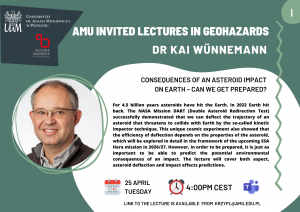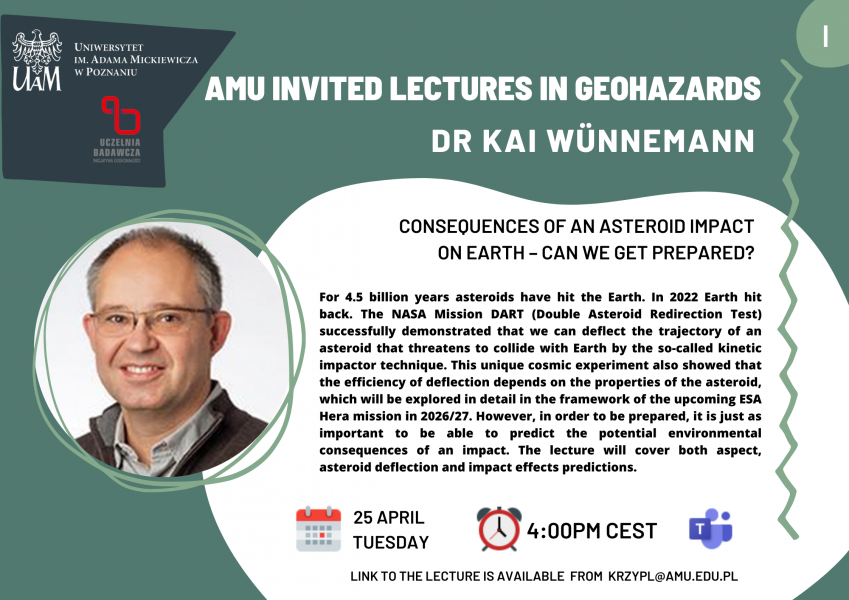Serdecznie zapraszamy do wzięcia udziału w wykładzie online pod tytułem “Consequences of an asteroid impact on Earth – can we get prepared?”, który wygłosi dr Kai Wünnemann (Museum für Naturkunde, Leibniz-Institut für Evolutions- und Biodiversitätsforschung, Berlin, Niemcy). Wykład stanowi część serii “AMU Invited Lecture Series in Geohazards I” organizowanej przez Uniwersytet im. Adama Mickiewicza w Poznaniu w ramach programu ID UB UAM. Wykład odbędzie się we wtorek (25 kwietnia) o godzinie 16:00 na platformie MS Teams (link: https://t.ly/9wJfG). Wykład i otwarta dyskusja po wykładzie będą w języku angielskim.
Informacja o wykładowcy i wykładzie:
Doctor Kai Wünnemann is an author of 85 papers focused mainly on asteroid/ meteorite impact modeling and landslides. His main research areas include investigating impact processes in the solar system with computer simulations, improved understanding of the highly dynamic processes during the collision of extraterrestrial bodies with planetary surfaces, and focusing on crater formation and collapse. He is also investigating ejecta ballistics and ejecta plume, impact melt and shock metamorphism, oceanic impacts, and the construction of tsunamis and gravitational mass movements, e.g., marine landslides in coastal regions caused by earthquakes or volcanic eruptions. His works apply computer models to study the interaction of the sliding body with water and wave formation, wave propagation in the ocean, and the contact of tsunamis with the coast. This kind of study help to improve the forecast and quantification of the impacts and risks of landslides in coastal regions. Recently, he served as Deputy head of the Science Programme "Evolution and Geoprocesses" and head of the section "Impact and Meteorite Research" at MfN.
Abstract:
For 4.5 billion years asteroids have hit the Earth. In 2022 Earth hit back. The NASA Mission DART (Double Asteroid Redirection Test) successfully demonstrated that we can deflect the trajectory of an asteroid that threatens to collide with Earth by the so-called kinetic impactor technique. This unique cosmic experiment also showed that the efficiency of deflection depends on the properties of the asteroid, which will be explored in detail in the framework of the upcoming ESA Hera mission in 2026/27. However, in order to be prepared, it is just as important to be able to predict the potential environmental consequences of an impact. The lecture will cover both aspect, asteroid deflection and impact effects predictions.


